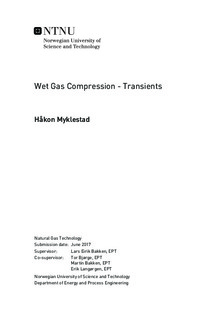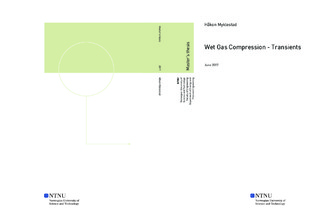| dc.description.abstract | Today, most of the large and easily accessible oil and gas fields on the Norwegian
continental shelf has been developed. Future production potential is found in development
of fields at large depths and cost-efficient methods of improving the recovery
of existing fields at the tail production stage. Development of wet gas compression
technology for subsea boosting is one pathway to achieving this.
Introducing multiphase flow into the already complex flow pattern inside compressors
makes it challenging to develop accurate analytical models. Current research
is therefore highly dependent on test data from real scale compressor rigs.
One such compressor rig is built at the Department of Energy and Process Engineering.
This thesis focus on transients aerodynamics phenomenons in centrifugal compressors.
These primarily occur at low flow rate where the compressors performance
is limited by stall and surge. Encountering stall or surge is highly unwanted during
operation and it is therefore of interest to investigate how wet gas affect them.
A compressor that is exposed directly to the wellstream also needs to handle inlet
instabilities in the form of liquid content fluctuations, especially if the downstream
pipelines are prone to slug formation. This is a unique challenge for wet gas compressors.
A vibration approach is taken, and the author has focused on analysis of frequency
spectra, primarily based on dynamic pressure readings in the diffuser. The
results show a mild increase of noise during wet conditions due to the dispersed
liquid droplets causing reflection of pressure waves. Left limit tests suggest that the
compressor encounters impeller rotating stall that is severe enough to cause flow
instabilities, but no signs of surge oscillations are seen. The same is observed for
wet gas, but this occurs at a lower flow rate. Slug tests performed in the surge area
gives no indication of instability, as the stall cells are immediately re-energized and
no excitations are observed around the rotors natural frequency. | |

